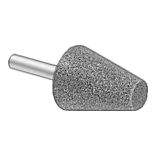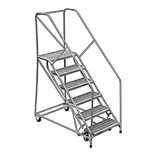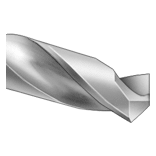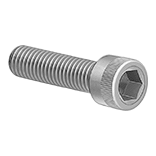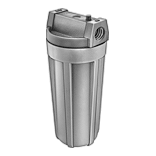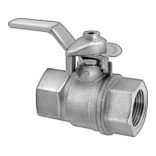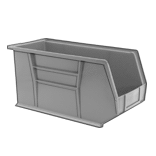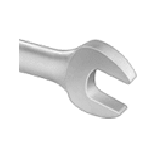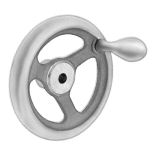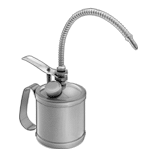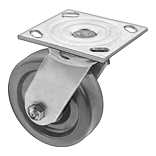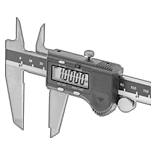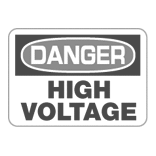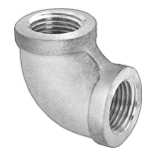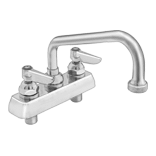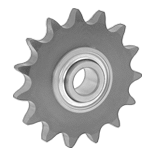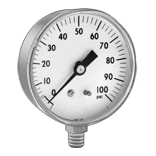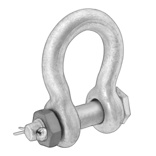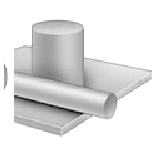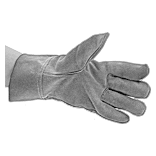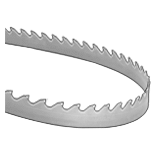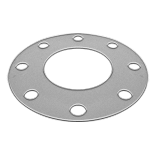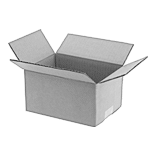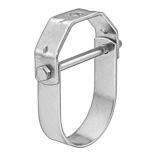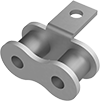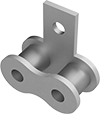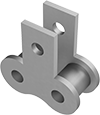About Roller Chain and Sprockets
More
ANSI Roller Chain and Links
Connecting links are also known as master links. They're used to join the ends of a chain length. The side plate is easy to remove for attaching to a chain. Adding links are also known as roller links. They require two connecting links to join chain. Adding-and-connecting links are also known as half links and offset links. A combination of connecting and adding links, they join chain that requires an odd number of links. For trade size 35 and up, the side plate is easy to remove for attaching them to chain.
For technical drawings and 3-D models, click on a part number.
Heavy Duty ANSI Roller Chain and Links
Thick side plates allow this chain to handle greater shock loads, like start/stop applications, than standard chain.
Connecting links are also known as master links. They're used to join the ends of a chain length. The side plate is easy to remove for attaching to a chain. Adding links are also known as roller links. They require two connecting links to join chain. Adding-and-connecting links are also known as half links and offset links. A combination of connecting and adding links, they can join chain that requires an odd number of links. The side plate is easy to remove for attaching to chain.
For technical drawings and 3-D models, click on a part number.
Corrosion-Resistant ANSI Roller Chain and Links
This 304 stainless steel roller chain is more corrosion resistant than treated steel roller chain.
Connecting links are also known as master links. They're used to join the ends of a chain length. The side plate is easy to remove for attaching to a chain. Adding links are also known as roller links. They require two connecting links to join chain. Adding-and-connecting links are also known as half links and offset links. A combination of connecting and adding links, they can join chain that requires an odd number of links. For trade size 35 and up, the side plate is easy to remove for attaching them to chain.
For technical drawings and 3-D models, click on a part number.
High-Strength Corrosion-Resistant ANSI Roller Chain and Links
This treated steel chain has over eight times the capacity of stainless steel chain.
Connecting links are also known as master links. They're used to join the ends of a chain length. The side plate is easy to remove for attaching to a chain. Adding links are also known as roller links. They require two connecting links to join chain. Adding-and-connecting links are also known as half links and offset links. A combination of connecting and adding links, they can join chain that requires an odd number of links. The side plate is easy to remove for attaching to chain.
For technical drawings and 3-D models, click on a part number.
Maintenance-Free ANSI Roller Chain and Links



With oil-embedded bushings and oil-coated pins, this chain is self-lubricating, which means it requires less maintenance than standard ANSI roller chain.
Connecting links are also known as master links. They're used to join the ends of a chain length. The side plate is easy to remove for attaching to a chain. Adding-and-connecting links are also known as half links and offset links. They can join chain that requires an odd number of links. The side plate is easy to remove for attaching to chain.
For technical drawings and 3-D models, click on a part number.
High-Strength Corrosion-Resistant Double-Pitch ANSI Roller Chain and Links




This treated steel chain has over six times the capacity of stainless steel chain. Designed for long drives and low- to moderate-speed applications, its links are twice as long as those found on other roller chain. Use with standard sprockets with at least 24 teeth.
Trade No. C2060H and C2080H chain have thick side plates to handle double the working loads of standard chain.
Connecting links are also known as master links. They're used to join the ends of a chain length. The side plate is easy to remove for attaching to a chain. Adding links are also known as roller links. They require two connecting links to join chain. Adding-and-connecting links are also known as half links and offset links. A combination of connecting and adding links, they can join chain that requires an odd number of links. The side plate is easy to remove for attaching to chain.
For technical drawings and 3-D models, click on a part number.
| Roller Chain Trade No. | Pitch | Roller Dia. | Roller Wd. | Working Load, lbs. | Each | |
Connecting Links | ||||||
|---|---|---|---|---|---|---|
Single Strand | ||||||
Corrosion-Resistant-Coated Steel | ||||||
| C2080H | 2" | 0.625" | 5/8" | 2,400 | 00000000 | 00000 |
Adding Links | ||||||
Single Strand | ||||||
Corrosion-Resistant-Coated Steel | ||||||
| C2080H | 2" | 0.625" | 5/8" | 2,400 | 00000000 | 00000 |
Adding-and-Connecting Links | ||||||
Single Strand | ||||||
Corrosion-Resistant-Coated Steel | ||||||
| C2080H | 2" | 0.625" | 5/8" | 2,400 | 00000000 | 00000 |
Corrosion-Resistant Double-Pitch ANSI Roller Chain and Links




Made of stainless steel, this chain has excellent corrosion resistance. Designed for long drives and low- to moderate-speed applications, its links are twice as long as those found on other roller chain. Use with standard sprockets with at least 24 teeth.
Trade No. C2060H-SS and C2080H-SS chain have thick side plates to handle double the working loads of standard chain.
Connecting links are also known as master links. They're used to join the ends of a chain length. The side plate is easy to remove for attaching to a chain. Adding links are also known as roller links. They require two connecting links to join chain. Adding-and-connecting links are also known as half links and offset links. A combination of connecting and adding links, they can join chain that requires an odd number of links. The side plate is easy to remove for attaching to chain.
For technical drawings and 3-D models, click on a part number.
| Roller Chain Trade No. | Pitch | Roller Dia. | Roller Wd. | Working Load, lbs. | Each | |
Connecting Links | ||||||
|---|---|---|---|---|---|---|
Single Strand | ||||||
304 Stainless Steel | ||||||
| C2080H-SS | 2" | 0.625" | 5/8" | 390 | 0000000 | 000000 |
Adding Links | ||||||
Single Strand | ||||||
304 Stainless Steel | ||||||
| C2080H-SS | 2" | 0.625" | 5/8" | 390 | 0000000 | 00000 |
Adding-and-Connecting Links | ||||||
Single Strand | ||||||
304 Stainless Steel | ||||||
| C2080H-SS | 2" | 0.625" | 5/8" | 390 | 0000000 | 00000 |
Double-Pitch ANSI Roller Chain and Links




With links that are twice as long as other roller chain links, this lightweight chain is designed for long drives and low- to moderate-speed applications. Use with standard sprockets with at least 24 teeth.
Trade No. C2060H and C2080H chain have thick side plates to handle double the working loads of standard chain.
Connecting links are also known as master links. They're used to join the ends of a chain length. The side plate is easy to remove for attaching to a chain. Adding links are also known as roller links. They require two connecting links to join chain. Adding-and-connecting links are also known as half links and offset links. A combination of connecting and adding links, they can join chain that requires an odd number of links. The side plate is easy to remove for attaching to chain.
For technical drawings and 3-D models, click on a part number.
Hollow-Pin ANSI Roller Chain and Links



This steel chain handles higher loads than stainless steel chain. Hollow-pin-style bushings let you add attachments without disassembling the chain.
Connecting links are also known as master links. They're used to join the ends of a chain length. The side plate is easy to remove for attaching to a chain. Adding-and-connecting links are also known as half links and offset links. They can join chain that requires an odd number of links. The side plate is easy to remove for attaching to chain.
For technical drawings and 3-D models, click on a part number.
ANSI Roller Chain Attachment Links
Add these links to your roller chain to attach brackets or guides, or to move materials directly. Use them for conveying, timing, and aligning. Do not use with Maintenance-Free ANSI Roller Chain.
Connecting links are also known as master links. They're used to join the ends of a chain length. The side plate is easy to remove for attaching to a chain. Adding links are also known as roller links. They require two connecting links to join chain.
Tab links have holes on the tabs for mounting parts and hanging hooks. Pin links have extended pins for tripping switches.
For technical drawings and 3-D models, click on a part number.
Corrosion-Resistant ANSI Roller Chain Attachment Links
Made of treated steel, these links offer increased corrosion resistance over steel attachment links. Add them to your roller chain to attach brackets or guides, or to move materials directly. Use them for conveying, timing, and aligning. Holes on the tabs allow you to mount parts or hang hooks. Also known as master links, they're used to join the ends of a chain length. The side plate is easy to remove for attaching to a chain. Do not use with Maintenance-Free ANSI Roller Chain.
Tab links have holes on the tabs for mounting parts and hanging hooks.
For technical drawings and 3-D models, click on a part number.


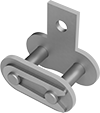
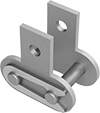
| Roller Chain Trade No. | Working Load, lbs. | Tab Lg. | Mount. Hole Dia. | Each | |
A-1 | |||||
|---|---|---|---|---|---|
Corrosion-Resistant-Coated Steel | |||||
| 80 | 4,250 | 0.851" | 0.268" | 0000000 | 00000 |
K-1 | |||||
Corrosion-Resistant-Coated Steel | |||||
| 80 | 4,250 | 0.851" | 0.268" | 0000000 | 00000 |
SA-1 | |||||
Corrosion-Resistant-Coated Steel | |||||
| 80 | 4,250 | 0.934" | 0.268" | 0000000 | 0000 |
SK-1 | |||||
Corrosion-Resistant-Coated Steel | |||||
| 80 | 4,250 | 0.934" | 0.268" | 0000000 | 00000 |
Flat-Edge ANSI Roller Chain Attachment Links






Flat, oblong side plates make these links ideal for use with flat-edge ANSI roller chain. Add them to your roller chain to attach brackets or guides, or to move materials directly. Use them for conveying, timing, and aligning.
Connecting links are also known as master links. They're used to join the ends of a chain length. The side plate is easy to remove for attaching to a chain.
Adding links are also known as roller links. They require two connecting links to join chain.
For technical drawings and 3-D models, click on a part number.
| Roller Chain Trade No. | Working Load, lbs. | Tab Lg. | Mount. Hole Dia. | Each | |
A-1 | |||||
|---|---|---|---|---|---|
Tab Connecting Links—Steel | |||||
| C2080H | 2,400 | 0.957" | 0.266" | 0000000 | 00000 |
Tab Adding Links—Steel | |||||
| C2080H | 2,400 | 0.961" | 17/64" | 0000000 | 0000 |
K-1 | |||||
Tab Connecting Links—Steel | |||||
| C2080H | 2,400 | 0.957" | 0.266" | 0000000 | 00000 |
Tab Adding Links—Steel | |||||
| C2080H | 2,400 | 0.961" | 17/64" | 0000000 | 00000 |
SA-1 | |||||
Tab Connecting Links—Steel | |||||
| C2080H | 2,400 | 1.138" | 0.406" | 0000000 | 0000 |
SK-1 | |||||
Tab Connecting Links—Steel | |||||
| C2080H | 2,400 | 1.138" | 0.406" | 0000000 | 00000 |
Tab Adding Links—Steel | |||||
| C2080H | 2,400 | 1.138" | 17/64" | 0000000 | 00000 |
